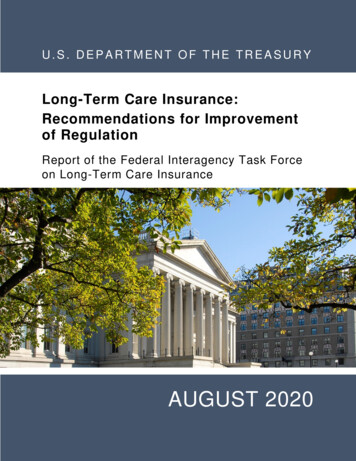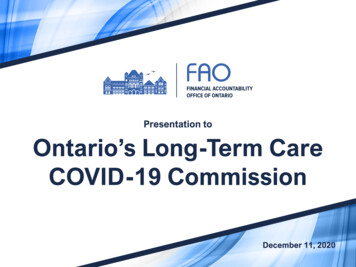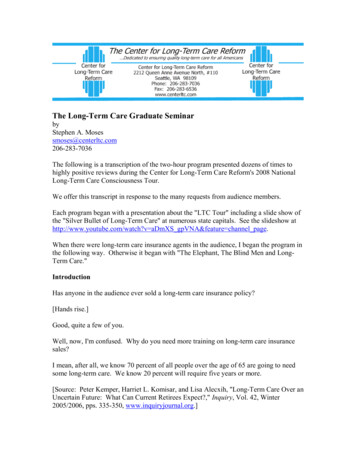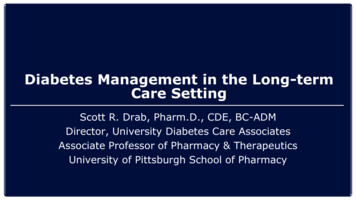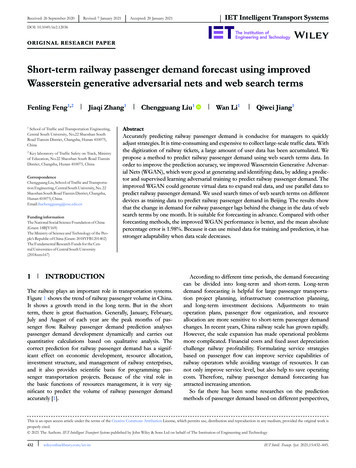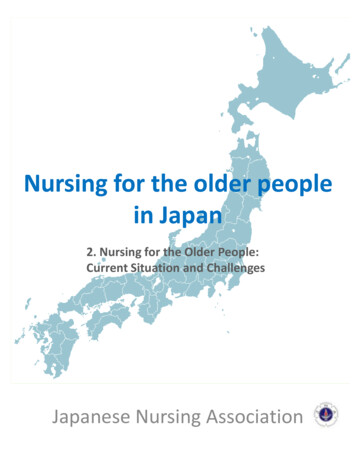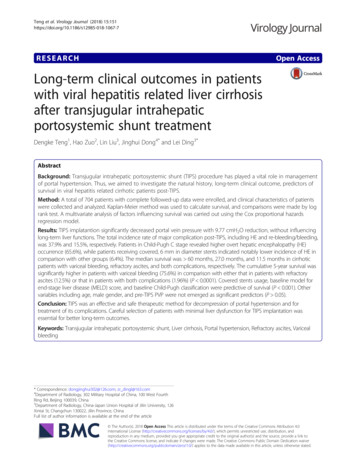
Transcription
Teng et al. Virology Journal (2018) EARCHOpen AccessLong-term clinical outcomes in patientswith viral hepatitis related liver cirrhosisafter transjugular intrahepaticportosystemic shunt treatmentDengke Teng1, Hao Zuo2, Lin Liu3, Jinghui Dong4* and Lei Ding3*AbstractBackground: Transjugular intrahepatic portosystemic shunt (TIPS) procedure has played a vital role in managementof portal hypertension. Thus, we aimed to investigate the natural history, long-term clinical outcome, predictors ofsurvival in viral hepatitis related cirrhotic patients post-TIPS.Method: A total of 704 patients with complete followed-up data were enrolled, and clinical characteristics of patientswere collected and analyzed. Kaplan-Meier method was used to calculate survival, and comparisons were made by logrank test. A multivariate analysis of factors influencing survival was carried out using the Cox proportional hazardsregression model.Results: TIPS implatantion significantly decreased portal vein pressure with 9.77 cmH2O reduction, without influencinglong-term liver functions. The total incidence rate of major complication post-TIPS, including HE and re-bleeding/bleeding,was 37.9% and 15.5%, respectively. Patients in Child-Pugh C stage revealed higher overt hepatic encephalopathy (HE)occurrence (65.6%), while patients receiving covered, 6 mm in diameter stents indicated notably lower incidence of HE incomparison with other groups (6.4%). The median survival was 60 months, 27.0 months, and 11.5 months in cirrhoticpatients with variceal bleeding, refractory ascites, and both complications, respectively. The cumulative 5-year survival wassignificantly higher in patients with variceal bleeding (75.6%) in comparison with either that in patients with refractoryascites (12.5%) or that in patients with both complications (1.96%) (P 0.0001). Covered stents usage, baseline model forend-stage liver disease (MELD) score, and baseline Child-Pugh classification were predictive of survival (P 0.001). Othervariables including age, male gender, and pre-TIPS PVP were not emerged as significant predictors (P 0.05).Conclusion: TIPS was an effective and safe therapeutic method for decompression of portal hypertension and fortreatment of its complications. Careful selection of patients with minimal liver dysfunction for TIPS implantation wasessential for better long-term outcomes.Keywords: Transjugular intrahepatic portosystemic shunt, Liver cirrhosis, Portal hypertension, Refractory ascites, Varicealbleeding* Correspondence: dongjinghui302@126.com; zr dingl@163.com4Department of Radiology, 302 Military Hospital of China, 100 West FourthRing Rd, Beijing 100039, China3Department of Radiology, China-Japan Union Hospital of Jilin University, 126Xintai St, Changchun 130022, Jilin Province, ChinaFull list of author information is available at the end of the article The Author(s). 2018 Open Access This article is distributed under the terms of the Creative Commons Attribution 4.0International License (http://creativecommons.org/licenses/by/4.0/), which permits unrestricted use, distribution, andreproduction in any medium, provided you give appropriate credit to the original author(s) and the source, provide a link tothe Creative Commons license, and indicate if changes were made. The Creative Commons Public Domain Dedication o/1.0/) applies to the data made available in this article, unless otherwise stated.
Teng et al. Virology Journal (2018) 15:151BackgroundPortal hypertension is one of the most common problems among patients with liver cirrhosis, and therapeuticapproaches of the complications are still the challengingtasks [1, 2]. Development of portal hypertension alwaysresults in the formation of collateral circulation in portalvein system, which leads to the portal venous flow intosystemic circulation and directly increase the incidenceof several clinical consequences, e.g. variceal bleedingand refractory ascites [3–7]. Although a variety of treatment methods have been built up, controversy remainsas to the most effective therapeutic algorithm for thecomplications of portal hypertension [8, 9].Transjugular intrahepatic portosystemic shunt (TIPS)surgery inserted metal stent into the liver parenchymaradiologically to establish a shunt between portal veinand hepatic vein/inferior vena cava. It is an efficientmethod for reducing portal pressure, and has beenwidely used for treatment of complications of portalhypertension [10, 11]. TIPS has gradually become thefirst-line therapeutic choice for cirrhotic patients withacute variceal hemorrhage who failed with endoscopichemostasis [12, 13], with an estimated technical successful rate of 93–100% [2]. TIPS is also used in treatmentof refractory ascites [14–16] and hepatorenal syndrome[17] due to the circulatory effects on portal hypertension. However, there have been concerns about TIPSimplantation, especially with high rate of hepatic encephalopathy (HE) post-TIPS [14]. More recently, thedevelopment and usage of covered metal stents significantly reduce the shunt dysfunction in comparison withbare mental stents insertion [18], leading to the lowerocclusion rate of consecutive bleeding and improvementof overall survival [19, 20]. However, few studies focusedon the long-term outcomes of patients receiving TIPSfor complications of portal hypertension and liver cirrhosis, especially with respect to variceal bleeding versusrefractory ascites. Thus, in this retrospective study, weevaluated the long-term efficacy and outcomes of TIPSin treatment of variceal bleeding and/or refractory ascites. The major objectives of the present study were toobserve the occurrence of clinical complications of TIPS,and predictors of survival.MethodsPatients and followed-upWe screened integrated database which included a totalof 1024 patients with viral hepatitis related liver cirrhosiswho underwent TIPS insertion between June 2004 andDecember 2012 in China-Japan Union Hospital and 302Military Hospital. The indication for TIPS treatmentincluded acute or recurrent variceal bleeding and refractory ascites. TIPS insertion was technically not feasiblein 89 patients, including 46 patients with unsuccessfulPage 2 of 7portal vein puncture, 28 patients with portal vein malformation, and 15 patients with portal vein thrombosis.There were 231 cases who were lost to follow-up afterTIPS insertion. Thus, eventually 704 patients withcomplete 5-year followed-up data or confirmed deathwithin 5-year followed-up period were enrolled in thisstudy. The TIPS procedures were accomplished by different specialists followed with the same protocol. Anticoagulant drugs, ornithine aspartate, and lactulose wereroutinely used after TIPS insertion. All patients weretreated for primary diseases in the followed-up period,such as nucleos(t)ide analogue therapy for HBV infection. Followed-up data were obtained by in-patients/out-patients visit, or telephone calls every year. Biochemical and ultrasound assessments were performed asroutine examination. The study protocol was approvedby Ethics Committees of both China-Japan Union Hospital and 302 Military Hospital on December 2016, anddata were collected on January and February 2017.Assessment of clinical characteristicsTIPS procedures were conducted using standard techniques [21]. Serum biochemical assessments (includingalanine aminotransferase [ALT], aspartate aminotransferase [AST], albumin [ALB], total bilirubin [T-BIL],blood urea nitrogen [BUN], and serum creatinine [Cr])were measured using an automatic analyzer (Hitachi7170A, Hitachi Ltd., Tokyo, Japan). Coagulation function(including prothrombin time [PT], thrombin time [TT],activated partial thromboplastin time [APTT], fibrinogen[Fib], prothrombin activity [PTA], and international normalized ratio [INR]) were measured using a coagulationanalyzer (PUN-2048, Perlong Medical Products, Beijing,China). Abdominal ultrasound examination was measured using a Doppler ultrasound diagnostic apparatus(NemioXG, Toshiba, Tokyo, Japan). The stiffness of liverwas measured using FibroScan 502 (Echosens, Pairs,France). The severity of liver disease was assessed usingtraditional Child-Pugh classification as described previously [22, 23]. T-BIL, ALB, INR, ascites, and HE gradewas involved for Child-Pugh scoring.Statistical analysisAll data were analyzed using SPSS version 19.0 for Windows Software (SPSS Inc., Chicago, IL, USA). Wilcoxon’smatched pairs test or Dunn’s multiple comparison testwere used for comparison of quantitative data. Chisquared test was used for comparison of categorical data.Kaplan-Meier method was employed to calculate survival from the time of TIPS treatment, and comparisonswere made by log rank test. A multivariate analysis offactors influencing survival was carried out using theCox proportional hazards regression model. The potential predictor variables for survival was age, male gender,
Teng et al. Virology Journal (2018) 15:151Page 3 of 7and pre-TIPS PVP, complications, stents usage, modelfor end-stage liver disease (MELD) score, and ChildPugh classification. We firstly perform univariate analysis for each variable and then perform multivariateanalysis using all the variables. All tests were two-tailed,and P values of less than 0.05 were considered to indicate significant differences.ResultsBaseline characteristics of enrolled patientsThe retrospective cohort comprised 704 of liver cirrhoticpatients with TIPS insertion. Baseline characteristics ofenrolled patients were listed in Table 1. Of these patients, 581 (82.5%) showed variceal bleeding, 72 (10.2%)revealed refractory ascites, whereas 51 (7.3%) demonstrated both variceal bleeding and refractory ascites. Fivehundred and eleven (72.6%) patients were male and 193(27.4%) were female, with a mean age of 53.2 years.TIPS insertion significantly reduced PVP of patients withliver cirrhosis, but not ameliorated liver functionsIn all 704 enrolled patients with TIPS treatment, directmeasurements of portal vein pressure (PVP) were carried out in 487 cases before and after stent insertion.TIPS insertion significantly decreased PVP with 9.77cmH2O reduction (36.81 8.68 cmH2O vs. 27.04 7.79cmH2O, Wilcoxon’s matched pairs test, P 0.0001). Allpatients were also received anti-fibrosis and anti-primaryTable 1 Baseline clinical characteristics of enrolled patientsCharacteristicValuePatients enrolled (n)704Variceal bleeding581Refractory ascites72Variceal bleeding and refractory ascites51Age, years, (mean SD)53.2 13.6Gender, male/female, (n)511/193Cause of cirrhosis (n)HBV509HCV134HBV HCV52HBV HDV9Child-Pugh classification (n)A219B421C64MELD score, (mean SD)12.8 5.1Stiffness of liver, KPa, (mean SD)18.6 10.7Diameter of portal vein, cm, (mean SD)1.52 0.37Diameter of splenic vein, cm, (mean SD)0.96 0.21MELD model for end-stage liver diseasediseases therapies, and liver functions were assessed ineach visit. There were no remarkable differences in ALT,T-BIL, albumin, and stiffness of liver after TIPS insertionin comparison with baseline (Dunn’s multiple comparison test, P 0.05, Table 2). All patients were routinelytreated with anticoagulant drugs at a weight-dependentdose for 1 year after TIPS insertion, leading to the disturbance of blood coagulation which presented as the reduction in PTA and elevation in INR (Dunn’s multiplecomparison test, P 0.05 compared with baseline, Table 2).However, blood ammonia was also increased, especially inthe early stage after TIPS implantation, although ornithineaspartate were routinely used (Dunn’s multiple comparisontest, P 0.05 compared with baseline, Table 2).Complications after TIPS implantationThe major complications after TIPS therapy includedHE and re-bleeding/bleeding. The total incident rate ofHE and re-bleeding/bleeding was 37.9% and 15.5%, respectively. Patients with variceal bleeding and refractoryascites indicated higher incidences for both HE andre-bleeding/bleeding (Chi-squared test, P 0.05, Table 3).Patients with Child-Pugh C revealed a significant elevated incidence of HE than those with Child-Pugh A orB (Chi-squared test, P 0.01, Table 3). However, therewere no remarkable difference in the incidence ofre-bleeding/bleeding among Child-Pugh classification(Chi-squared test, P 0.05, Table 3). Moreover, uncovered (n 130) and covered (n 574) metal stents wereused for portosystemic shunt. No significant incidenceof HE and re-bleeding/bleeding were found between patients using uncovered and covered stents (Chi-squaredtest, P 0.05, Table 3). However, patients receiving covered, 6 mm in diameter stents indicated notably lowerincidence of HE in comparison with other groups(Chi-squared test, P 0.0001, Table 3).Patients survivalOverall median survival was 60 months with the cumulative 5-year survival of patients in 63.6% (Fig. 1a).The median survival was 60 months, 27.0 months, and11.5 months in cirrhotic patients with variceal bleeding,refractory ascites, and both complications, respectively.Moreover, the cumulative 5-year survival was significantly higher in patients with variceal bleeding (75.6%)in comparison with either that in patients with refractory ascites (12.5%, hazard ratio [HR] 69.28 [95% CI39.01–123.0], P 0.0001, Fig. 1b) or that in patients withboth complications (1.96%, HR 0.00025 [95% CI0.00011–0.00059], P 0.0001, Fig. 1b). On multivariateanalysis covered stents usage (HR 2.96 [95% CI 2.06–4.25], P 0.0001, Fig. 1c), baseline MELD score (HR 0.40 [95% CI 0.31–0.41], P 0.0001, Fig. 1d), and baseline Child-Pugh classification (Child-Pugh A versus
Teng et al. Virology Journal (2018) 15:151Page 4 of 7Table 2 Changes in liver functions of liver cirrhotic patients with TIPS treatmentBaseline1 year2 years3 years4 years(n 704)(n 638)(n 587)(n 530)(n 485)(n 445)ALT (U/L)51 2847 1955 3152 2158 2055 18T-BIL (μmol/L)29.2 19.734.8 20.132.9 21.835.9 20.834.6 19.727.6 18.0Albumin (g/L)28.9 10.229.1 11.730.0 9.828.7 8.229.7 9.2######5 years30.1 12.8#Blood ammonia (μmol/L)64.7 25.987.6 27.1PTA (%)56.8 12.537.8 9.1INR1.36 0.231.90 0.46 #1.48 0.511.50 0.491.50 0.441.47 0.38Stiffness (KPa)18.6 10.717.6 9.817.9 12.716.8 8.616.7 9.117.1 10.2P 0.05,####81.5 19.851.4 8.776.2 20.549.2 11.078.2 21.250.1 10.271.0 11.650.8 8.9P 0.01 compared with baseline, Dunn’s multiple comparison testChild-Pugh B, HR 0.73 [95% CI 0.54–0.98], P 0.038;Child-Pugh A versus Child-Pugh C, HR 0.034 [95% CI0.019–0.058], P 0.0001; Child-Pugh B versus ChildPugh C, HR 0.038 [95% CI 0.023–0.064], P 0.0001;Fig. 1e) were predictive of survival. Other variables included in the final Cox proportional hazards model wereage, male gender, and pre-TIPS PVP, but none emergedas significant predictors (P 0.05).DiscussionTo the best of our knowledge, the current study represented one of the largest cohort of patients who receivedTIPS as therapeutic method for the complications ofportal hypertension and liver cirrhosis, and followed-upfor the longest period of time, thereby allowing us tobetter understand plenty of issues related to TIPS implantation for variceal bleeding and/or refractory ascites.In this retrospective study, shunt insertion was successful in 91.3% (935/1024) of patients scheduled. Thebaseline characteristics revealed that distribution ofunderlying diseases was typical for China, with chronicviral hepatitis as the major causation for liver cirrhosis[24]. In agreement with previous findings [25–28], weconfirmed that TIPS is effective as treatment for varicealbleeding and refractory ascites in cirrhotic patients without improvement of liver function. TIPS implantationcould decrease the portal pressure gradient by 20–50%of the initial pressure, and maintained under 12 mmHg[29, 30]. This was consistent with the current results ofreduction in direct measurement of PVP. However, therewere no remarkable differences in the degree of reduction of PVP post-TIPS insertion among patients withvariceal bleeding and/or refractory ascites. Although theinitial reduction in PVP after TIPS insertion was considered to be a predictor for rebleeding risk, but not forTable 3 The incidence of major complications after TIPS treatmentTotalVariceal bleedingHERe-bleeding/Bleeding267/704 (37.9%)109/704 (15.5%)208/581 (35.8%)81/581 (13.9%)Refractory ascites31/72 (43.1%)6/72 (8.3%)Variceal bleeding and refractory ascites28/51 (54.9%) #22/51 (43.1%) ##A83/219 (37.8%)37/219 (16.9%)B142/421 (33.7%)61/421 (14.5%)C42/64 (65.6%) ##11/64 (17.2%)56/130 (43.1%)17/130 (13.1%)Diameter of stent 8 mm (n 47)17/47 (36.1%)5/47 (10.6%)Diameter of stent 10 mm (n 83)39/83 (47.0%)12/83 (14.5%)Child-Pugh classificationType of stentUncovered stent (n 130)Covered stent (n 574)211/574 (36.8%)92/574 (16.0%)Diameter of stent 6 mm (n 94)6/94 (6.4%) ###14/94 (14.9%)Diameter of stent 7 mm (n 178)67/178 (37.6%)31/178 (17.4%)Diameter of stent 8 mm (n 302)138/302 (45.7%)47/302 (15.6%)P 0.05,###P 0.01, and###P 0.01 compared with other groups, Chi-squared test
Teng et al. Virology Journal (2018) 15:151Page 5 of 7Fig. 1 Kaplan-Meier survival analysis of patients after transjugular intrahepatic portosystemic shunt (TIPS) implantation. a Overall survival. bComparison of probability of survival among patients with variceal bleeding and/or refractory ascites. c Comparison of probability of survivalbetween patients with uncovered and covered stent. d Comparison of probability of survival between patients with baseline MELD score 10and 10. e Comparison of probability of survival among patients with different Child-Pugh stagesurvival [31], we did not find notable correlation between baseline/reduction of PVP and survival, indicatingthat PVG might not be the predictor for survivalpost-TIPS treatment.In consistent with Membreno et al. [32] and Heinzowet al. [2], the current results demonstrated that overalllong-term survival was significantly better in patientswith TIPS due to variceal bleeding ( 60 months) thanthat in patients with TIPS due to refractory ascites(27.0 months), while the combination of both complications further worsened the survival (11.5 months, P 0.001) with higher rate of major complications. Theoverall occurrence of HE was nearly 40% which washigher than previous reports, although we routinely prescribed ornithine aspartate and lactulose to all patientspost-TIPS. The use of smaller diameter stents might beassociated with lower risk of HE post-TIPS, as the development of refractory HE requiring reduction in shuntdiameter in 8–10% of patients [33]. This was in accordance with our results showing the lower HE occurrencein patients with 6 mm-diameter of stent insertion,although elevated risk of treatment failure was alsoobserved among patients with smaller 8-mm stent froma randomized controlled trials [34].TIPS implantation increased the risk of acute liverand/or cardiac decompensation and failure. Thus, careful selection of patients with liver cirrhosis and portalhypertension was crucial to the successful outcomepost-TIPS [35, 36]. Previous study revealed that betterliver function might respond better to TIPS insertion[37]. The baseline age 55 years, T-BIL 35 μmol/L, andserum sodium 135 mmol/L indicated beneficial survival post-TIPS. Original Child-Pugh stage [2], modifiedChild-Na score with serum sodium incorporation [38],and MELD score [39] were independent prognostic factor of survival. We showed that patients in Child-PughC stage demonstrated higher incidence of overt HE.Moreover, in agreement with previous findings, ChildPugh stage and MELD score were significant indicatorfor survival post-TIPS, probably due to the fact that bothscoring systems were validated tools for assessing prognosis [40]. Thus, approximate 60% of overall 5-year survival was not surprising as the enrolled patients hadminimal liver dysfunction at baseline.Uncovered metal stents were one of the treatmentchoice for establishing TIPS tracts [41], with approximate 20% use of all TIPS procedures in United States[42]. The higher rate of shunt dysfunction with consecutive bleeding complications [43] has been largely overcome after the development of covered metal stents [18,19, 44]. Although Bureau and colleagues did not detectsurvival benefit of covered and bare stents [45], morerecently meta-analyses of randomized controlled trialsrevealed that covered stents for TIPS improved overallsurvival [20], especially in prevention of varicealre-bleeding [46]. In addition, it was also reported that1-year probability of remaining free of HE in patientswith post-covered TIPS was numerically lower than thatwith bare stents [35, 47]. In the present study, we foundthat there were no remarkable differences in the
Teng et al. Virology Journal (2018) 15:151occurrences of either HE or re-bleeding between coveredand uncovered stents. Furthermore, the use of coveredstents was predictive of beneficial survival, which wassimilar to the findings by Tan et al. in refractory ascites[35]. This was partly due to the better baseline liverfunction in covered stents groups, which was also foundin Tan’s study [35]. Moreover, since most covered stentswere used in recent years, the improvement in procedurerelated skills with primary patency up to 90% within firstyear application also accounted for superiority of coveredstents [19, 35]. Thus, as expected, the improved survivalwas due to era effect rather than type of stents [35], whichfurther deepened the understanding of patients selectionfor TIPS implantation.There were some limitations in this study. First, weconducted a retrospective study with limited patientsnumbers and no control group was established. Thus,large-scale, random control studies were needed toconfirm the current results. Second, we tried to identifypredictors for liver failure in patients post-TIPS. However, the definition for liver failure was hard. The classical definition for liver failure contains jaundice(T-BIL 170 μmol/L) and coagulopathy (PTA 40%).The use of anticoagulant drugs down-regulated PTAlevel, which made it hard for definition. Furthermore,only few patients suffered with high jaundice post-TIPS.Thus, we did not analyze predictors for liver failurepost-TIPS. Third, the factors regarding the cause ofcirrhosis were lacking in survival analysis after TIPS.Fourth, the cause of death of patients did not analyzedin the current study.ConclusionTIPS was an effective and safe therapeutic method fordecompression of portal hypertension and for treatmentof its complications. Child-Pugh stage and MELD scorewere independent predictors of survival in patients withTIPS implantation. Thus, careful selection of patients forTIPS was essential for better long-term outcomes.AbbreviationsALT: Alanine aminotransferase; APTT: Activated partial thromboplastin time;AST: Aspartate aminotransferas; BUN: Blood urea nitrogen; Cr: Creatinine;Fib: Fibrinogen; HE: Hepatic encephalopathy; HR: Hazard ratio;INR: International normalized ratio; MELD: Model for end-stage liver disease;PT: Prothrombin time; PTA: Prothrombin activity; PVP: Portal vein pressure; TBIL: Total bilirubin; TIPS: Transjugular intrahepatic portosystemic shunt;TT: Thrombin timeAuthors’ contributionsJD designed and supervised the study. LD, DT, and LL acquisition of data.LD, DT, HZ, LL, and JD analyzed and interpreted the data. LD, DT, HZ, and JDprepared the manuscript. All authors read and approved the finalmanuscript.Ethics approval and consent to participateThe study protocol was approved by Ethics Committees of both China-JapanUnion Hospital and 302 Military Hospital on December 2016.Page 6 of 7Consent for publicationNot applicable.Competing interestsThe authors declare that they have no competing interests.Publisher’s NoteSpringer Nature remains neutral with regard to jurisdictional claims inpublished maps and institutional affiliations.Author details1Department of Ultrasound, China-Japan Union Hospital of Jilin University,Changchun 130022, Jilin Province, China. 2Department of Pain, The SecondHospital of Jilin University, Changchun 130041, Jilin Province, China.3Department of Radiology, China-Japan Union Hospital of Jilin University, 126Xintai St, Changchun 130022, Jilin Province, China. 4Department ofRadiology, 302 Military Hospital of China, 100 West Fourth Ring Rd, Beijing100039, China.Received: 14 June 2018 Accepted: 25 September 2018References1. Siramolpiwat S. Transjugular intrahepatic portosystemic shunts andportal hypertension-related complications. World J Gastroenterol. 2014;20:16996–7010.2. Heinzow HS, Lenz P, Kohler M, Reinecke F, Ullerich H, Domschke W,Domagk D, Meister T. Clinical outcome and predictors of survival afterTIPS insertion in patients with liver cirrhosis. World J Gastroenterol.2012;18:5211–8.3. Ertel AE, Chang AL, Kim Y, Shah SA. Management of gastrointestinalbleeding in patients with cirrhosis. Curr Probl Surg. 2016;53:366–95.4. Toshikuni N, Takuma Y, Tsutsumi M. Management of gastroesophagealvarices in cirrhotic patients: current status and future directions. AnnHepatol. 2016;15:314–25.5. Williams MJ, Hayes P. Improving the management of gastrointestinalbleeding in patients with cirrhosis. Expert Rev Gastroenterol Hepatol.2016;10:505–15.6. Garcia-Tsao G, Sanyal AJ, Grace ND, Carey W, Practice guidelinesCommittee of the American Association for the study of liver D,practice parameters Committee of the American College of G.Prevention and management of gastroesophageal varices and varicealhemorrhage in cirrhosis. Hepatology. 2007;46:922–38.7. Sanyal AJ, Bosch J, Blei A, Arroyo V. Portal hypertension and itscomplications. Gastroenterology. 2008;134:1715–28.8. Garcia-Tsao G. Current Management of the Complications of cirrhosis andportal hypertension: variceal hemorrhage, ascites, and spontaneous bacterialperitonitis. Dig Dis. 2016;34:382–6.9. Nguyen GC, Segev DL, Thuluvath PJ. Racial disparities in the managementof hospitalized patients with cirrhosis and complications of portalhypertension: a national study. Hepatology. 2007;45:1282–9.10. Tytle TL, Loeffler C, Thompson WM 3rd. Transjugular intrahepaticportosystemic shunt (TIPS): a promising nonsurgical treatment for bleedinggastroesophageal varices. J Okla State Med Assoc. 1993;86:220–4.11. Sanyal AJ, Genning C, Reddy KR, Wong F, Kowdley KV, Benner K,McCashland T, North American study for the treatment of refractory ascitesG. The north American study for the treatment of refractory ascites.Gastroenterology. 2003;124:634–41.12. Goykhman Y, Ben-Haim M, Rosen G, Carmiel-Haggai M, Oren R,Nakache R, Szold O, Klausner J, Kori I. Transjugular intrahepaticportosystemic shunt: current indications, patient selection and results.Isr Med Assoc J. 2010;12:687–91.13. Boyer TD, Haskal ZJ, American Association for the Study of liver D. The roleof Transjugular intrahepatic portosystemic shunt (TIPS) in the Managementof Portal Hypertension: update 2009. Hepatology. 2010;51:306.14. Forrest EH, Stanley AJ, Redhead DN, McGilchrist AJ, Hayes PC. Clinicalresponse after transjugular intrahepatic portosystemic stent shunt insertionfor refractory ascites in cirrhosis. Aliment Pharmacol Ther. 1996;10:801–6.15. Ochs A, Rossle M, Haag K, Hauenstein KH, Deibert P, Siegerstetter V,Huonker M, Langer M, Blum HE. The transjugular intrahepatic portosystemicstent-shunt procedure for refractory ascites. N Engl J Med. 1995;332:1192–7.
Teng et al. Virology Journal (2018) 15:15116. Narahara Y, Kanazawa H, Fukuda T, Matsushita Y, Harimoto H, KidokoroH, Katakura T, Atsukawa M, Taki Y, Kimura Y, et al. Transjugularintrahepatic portosystemic shunt versus paracentesis plus albumin inpatients with refractory ascites who have good hepatic and renalfunction: a prospective randomized trial. J Gastroenterol. 2011;46:78–85.17. Anderson CL, Saad WE, Kalagher SD, Caldwell S, Sabri S, Turba UC,Matsumoto AH, Angle JF. Effect of transjugular intrahepaticportosystemic shunt placement on renal function: a 7-year, singlecenter experience. J Vasc Interv Radiol. 2010;21:1370–6.18. Perarnau JM, Le Gouge A, Nicolas C, d'Alteroche L, Borentain P, SalibaF, Minello A, Anty R, Chagneau-Derrode C, Bernard PH, et al. Coveredvs. uncovered stents for transjugular intrahepatic portosystemic shunt: arandomized controlled trial. J Hepatol. 2014;60:962–8.19. Yang Z, Han G, Wu Q, Ye X, Jin Z, Yin Z, Qi X, Bai M, Wu K, Fan D.Patency and clinical outcomes of transjugular intrahepaticportosystemic shunt with polytetrafluoroethylene-covered stents versusbare stents: a meta-analysis. J Gastroenterol Hepatol. 2010;25:1718–25.20. Qi X, Tian Y, Zhang W, Yang Z, Guo X. Covered versus bare stents fortransjugular intrahepatic portosystemic shunt: an updated meta-analysis ofrandomized controlled trials. Therap Adv Gastroenterol. 2017;10:32–41.21. LaBerge JM, Ring EJ, Gordon RL, Lake JR, Doherty MM, Somberg KA,Roberts JP, Ascher NL. Creation of transjugular intrahepaticportosystemic shunts with the wallstent endoprosthesis: results in 100patients. Radiology. 1993;187:413–20.22. Tarantino G, Citro V, Conca P, Riccio A, Tarantino M, Capone D, CirilloM, Lobello R, Iaccarino V. What are the implications of the spontaneousspleno-renal shunts in liver cirrhosis? BMC Gastroenterol. 2009;9:89.23. Tarantino G, Citro V, Esposito P, Giaquinto S, de Leone A, Milan G,Tripodi FS, Cirillo M, Lobello R. Blood ammonia levels in liver cirrhosis:a clue for the presence of portosystemic collateral veins. BMCGastroenterol. 2009;9:21.24. Tang CM, Yau TO, Yu J. Management of chronic hepatitis B infection:current treatment guidelines, challenges, and new developments. WorldJ Gastroenterol. 2014;20:6262–78.25. Bissonnette J, Garcia-Pagan JC, Albillos A, Turon F, Ferreira C, Tellez L,Nault JC, Carbonell N, Cervoni JP, Abdel Rehim M, et al. Role of thetransjugu
All data were analyzed using SPSS version 19.0 for Win-dows Software (SPSS Inc., Chicago, IL, USA). Wilcoxon's matched pairs test or Dunn's multiple comparison test were used for comparison of quantitative data. Chi-squared test was used for comparison of categorical data. Kaplan-Meier method was employed to calculate sur-

